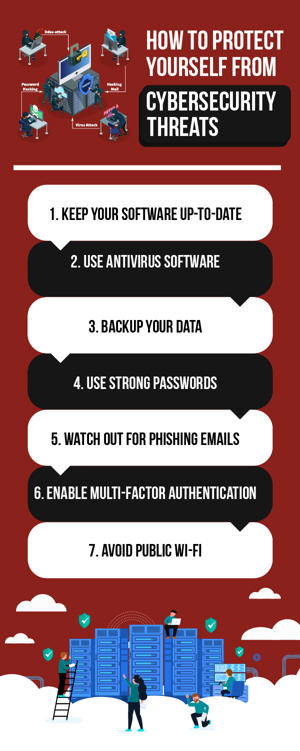How To Protect Yourself from Cyber Threats
Comprehensive Guide to Safeguarding Yourself Against Cyber Threats

Frequently Asked Questions
Common types of cyber threats include malware, phishing, identity theft, ransomware, and denial-of-service attacks. Understanding these threats can help you better protect yourself.
Two-factor authentication (2FA) adds a crucial layer of security that significantly reduces the risk of unauthorized access, even if someone gets hold of your password. It requires a second form of verification, which makes it much harder for cybercriminals to compromise your accounts.
Step by Step Guide
1
Understand Cyber Threats
To protect yourself, you first need to understand what cyber threats are. Cyber threats can include malware, phishing, identity theft, and hacking. Identify your vulnerabilities and the potential risks associated with your online activities.
2
Use Strong Passwords
Create complex passwords that combine letters, numbers, and symbols. Avoid using easily guessed information such as birthdays or common words. Consider using a password manager to keep track of multiple passwords securely.
3
Enable Two-Factor Authentication (2FA)
2FA adds an extra layer of security by requiring not just a password but also another form of identification. This could be a code sent to your phone or an authentication app.
4
Keep Software Updated
Regularly update your operating system, apps, and antivirus software to protect against vulnerabilities that can be exploited by cybercriminals. Enable automatic updates when possible.
5
Be Cautious with Public Wi-Fi
Avoid accessing sensitive information, such as banking details or personal emails, when connected to public Wi-Fi. If necessary, use a Virtual Private Network (VPN) to encrypt your connection.
6
Recognize Phishing Attempts
Learn how to identify fraudulent emails or messages designed to trick you into giving away personal information. Look for signs like poor grammar, generic greetings, and suspicious links.
7
Use Antivirus and Antimalware Software
Install reputable antivirus and antimalware programs on your devices. Regularly run scans to detect and remove any dangerous software that may have infiltrated your system.
8
Secure Your Home Network
Change the default password on your home router and ensure your Wi-Fi network is secured with WPA3 encryption. Regularly check for unknown devices connected to your network.
9
Regularly Monitor Your Accounts
Closely monitor your bank and credit accounts for any unauthorized transactions or signs of identity theft. If you notice something suspicious, act immediately.
10
Educate Yourself and Others
Stay informed about the latest cyber threats and trends. Share your knowledge with friends and family to empower them to protect themselves as well.








